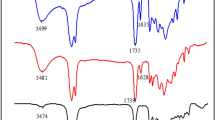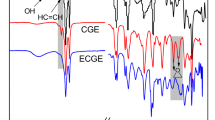Abstract
The influence of cashew nut shell oil (CNO), epoxidized soybean oil (ESO), castor oil (CO), and dioctyl phtalate (DOP) on the photocrosslinking kinetics of UV curable mixtures containing an o-cresol novolac epoxy resin (CNE), a bis-cycloaliphatic diepoxide monomer (BCDE), and a triarylsulfonium salt (TAS) as a cationic photoinitiator has been studied. The formulation with a weight ratio CNE/BCDE/TAS of 60/40/5 was found to have the highest cure rate and the greatest final conversion of epoxy groups upon UV exposure. The presence of an unsaturated oil or of DOP in the UV curable formulation, at a content ranging from 0.07 to 0.79 mol/kg, was shown to increase the initial polymerization rate of the epoxy groups from 12 up to 31 mol/kg s, and the epoxy conversion after 18 s UV exposure from 80 up to 95%. It was found that the UV cured coatings containing CNO or DOP at concentrations between 0.3 and 0.6 mol/kg and ESO at concentrations between 0.12 and 0.19 mol/kg exhibit the best performance. These results were explained by a number of competitive factors, mainly the effects of the chemical structure and content of the oils and of DOP on the polarity, viscosity, compatibility, and internal filter effect of the UV curable resins, as well as by the characteristics of the tridimensional polymer networks formed upon UV exposure. The materials produced under the optimal conditions determined in this study can be used as high performance decorative and protective coatings and also as adhesives in different sectors of applications.




Similar content being viewed by others
References
Kelly, A, Zweben, C, Comprehensive Composite Materials, Vol. 2, pp. 3–18. Elsevier, Oxford, 2000. ISBN: 0-08-043720-6
Kim, WG, Lee, JY, “Contributions of the Network Structure to the Cure Kinetics of Epoxy Resin Systems According to the Change of Hardeners.” Polymer, 43 5713–5722 (2002)
Suzuki, T, Oki, Y, Numajiri, M, Miura, T, Kondo, K, Shiomi, Y, Ito, Y, “Free-Volume Characteristics and Water Absorption of Novolac Epoxy Resins Investigated by Position Annihilation.” Polymer, 37 (14) 3025–3030 (1996)
González, S, Francos, XF, Salla, JM, Serra, A, Matecon, A, Ramis, X, “New Thermosets Obtained by the Cationic Copolymerization of Diglycidyl Ether of Bisphenol A with γ-Caprolactone with an Improvement in the Shrinkage. I-Study of the Chemical Processes and Physical Characteristics.” J. Polym. Sci. A: Polym. Chem., 45 (10) 1968–1979 (2007)
Ortiz, RA, López, DP, Cisneros, MLG, Valverde, JCR, Crivello, JV, “A Kinetic Study of the Acceleration Effect of Substituted Benzyl Alcohols on the Cationic Photopolymerization Rate of Epoxidized Natural Oils.” Polymer, 46 (1) 1535–1541 (2005)
Decker, C, Trieu, NTV, Hong, PT, “Photoinitiated Cationic Polymerization of Epoxides.” Polym. Int., 50 986–997 (2001)
Decker, C, “Effect of UV Radiation on Polymers.” In: Cheremisinoff, NP (ed.) Handbook of Polymer Science and Technology, Vol. 3, pp. 541–604. Dekker, New York, 1989
Crivello, JV, “UV and Electron Beam-Induced Cationic Polymerization.” Nucl. Instrum. Methods Phys. Res. B, 151 8–21 (1999)
Hien, LX, Hoang, VM, Trieu, NTV, “Study of the Photocrosslinking of the Photocrosslinkable System Based on Epoxy Resin Modified by Tung Oil. II. Influence of the Content of the Cationic Photoinitiator on the Photocrosslinking of the System ETT 39-6105-TAS.” J. Sci. Technol. VAST, 43 (2B) 131–136 (2005)
Hien, LX, Hoang, VM, Trieu, NTV, “Study of the Photocrosslinking of the Photocrosslinkable System Based on Epoxy Resin Modified by Tung Oil. IV. Study of Physico Mechanical Properties of the Photocured Coating on the Base of ETT 39-BCDE-TAS.” J. Sci. Technol. VAST, 45 (6) 255–260 (2007)
Trieu, NTV, Hien, LX, Hong, PT, “Epoxidation of Soya-Bean Oil by Performic Acid.” J. Chem. Vietnam NCNST, 37 (2) 9–12 (1999)
Сuльвepcтеǔн, PM, Гасслер, GC, Mоррuн, TC, Cneктрометрuчeская ugeнтuфuкацuя opганuческux соеguнeнuǔ, стр 125–276, uзgaтельстbo Mup, Moсквa (1977)
Decker, C, Hien, LX, Trieu, NTV, “Photocrosslinking of Functionalized Rubber. II. Photoinitiated Cationic Polymerization of Epoxidized Natural Rubber.” J. Polym. Sci. A: Polym. Chem., 33 2759–2772 (1995)
Decker, C, Trieu, NTV, Hien, LX, “Photoréticulation de caoutchoucs fonctionalisés. VI. Polymérisation cationique de caoutchoucs époxydés.” Eur. Polym. J., 32 (11) 1319–1331 (1996)
Thames, SF, Yu, H, Subramanian, R, “Cationic Ultraviolet Curable Coatings from Castor Oil.” J. Appl. Polym. Sci., 77 8–19 (2000)
Choudhary, V, Agarwal, N, Varma, IK, “Evaluation of Bisacrylate Terminated Epoxy Resins as Coatings.” Prog. Org. Coat., 57 223–228 (2006)
Acknowledgments
The authors are grateful to Ministry of Science and Technology of Vietnam for its financial supports.
Author information
Authors and Affiliations
Corresponding author
Rights and permissions
About this article
Cite this article
Hien, L.X., Minh, D.T.N., Trieu, N.T.V. et al. Influence of some vegetable oils on the photocrosslinking of coatings based on an o-cresol novolac epoxy resin and a bis-cycloaliphatic diepoxide. J Coat Technol Res 8, 343–353 (2011). https://doi.org/10.1007/s11998-010-9303-0
Published:
Issue Date:
DOI: https://doi.org/10.1007/s11998-010-9303-0




